BM533 Contemporary Business Economics: Demand, Supply, Theories
VerifiedAdded on 2023/06/17
|11
|3196
|394
Report
AI Summary
This report delves into key concepts of business economics, focusing on demand and supply analysis, and contrasting economic theories from the 20th and 21st centuries. It explains the laws of demand and supply, including movements along the curves and shifts in the curves, using illustrative diagrams. Furthermore, the report compares and contrasts Keynesian and Friedman theories, highlighting their relevance to modern business practices. The analysis provides a comprehensive overview of how these economic principles impact business decision-making and strategic planning, offering valuable insights for businesses seeking growth and success.
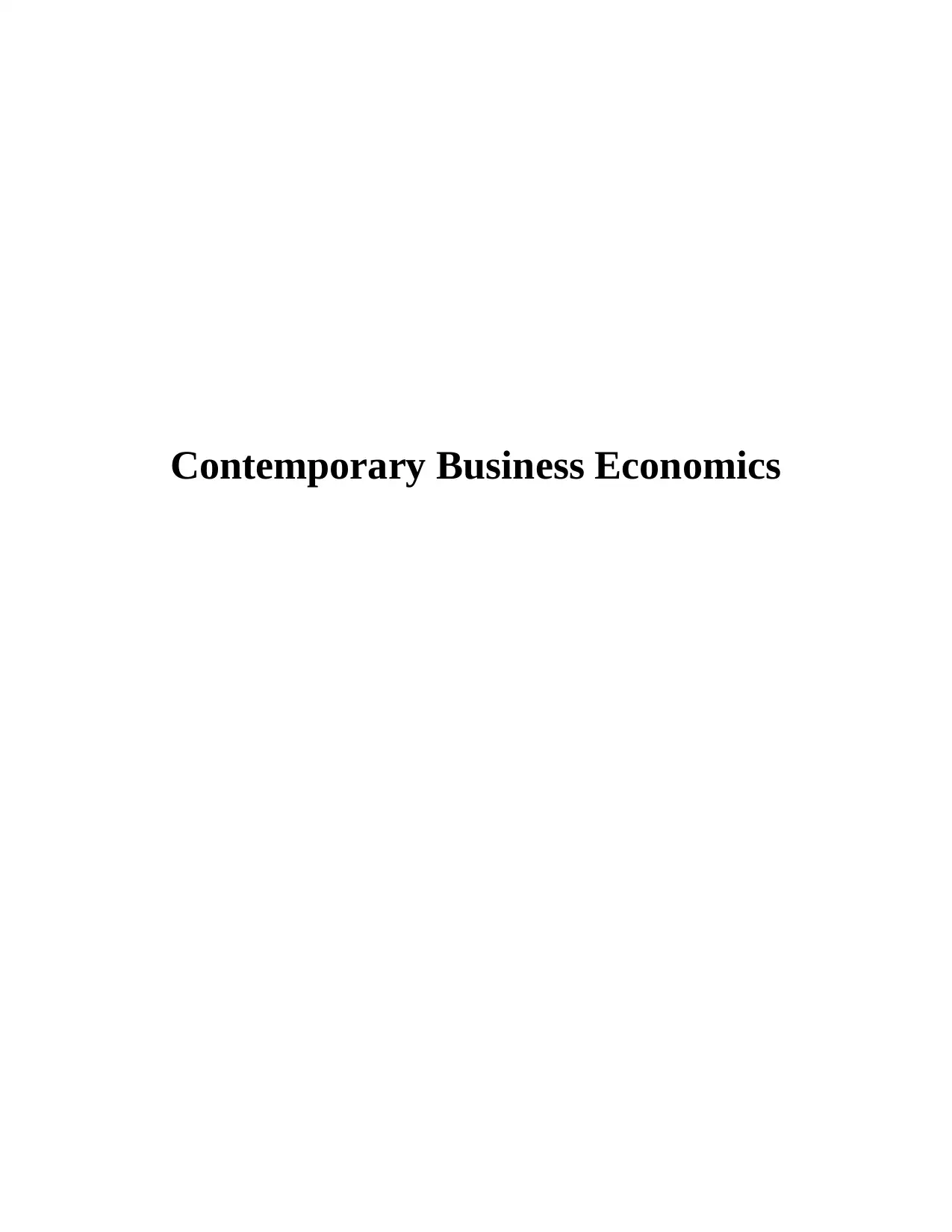
Contemporary Business Economics
Paraphrase This Document
Need a fresh take? Get an instant paraphrase of this document with our AI Paraphraser
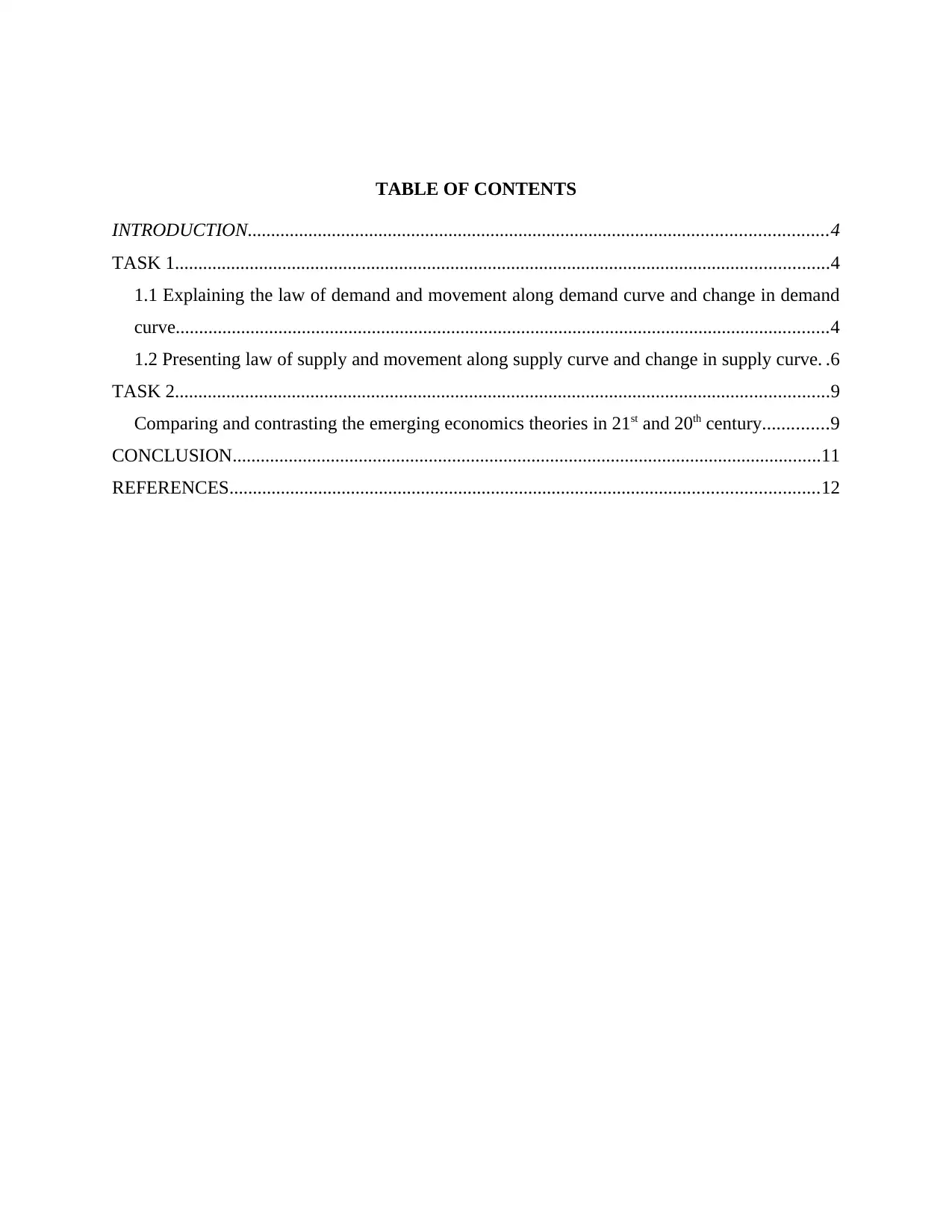
TABLE OF CONTENTS
INTRODUCTION............................................................................................................................4
TASK 1............................................................................................................................................4
1.1 Explaining the law of demand and movement along demand curve and change in demand
curve............................................................................................................................................4
1.2 Presenting law of supply and movement along supply curve and change in supply curve. .6
TASK 2............................................................................................................................................9
Comparing and contrasting the emerging economics theories in 21st and 20th century..............9
CONCLUSION..............................................................................................................................11
REFERENCES..............................................................................................................................12
INTRODUCTION............................................................................................................................4
TASK 1............................................................................................................................................4
1.1 Explaining the law of demand and movement along demand curve and change in demand
curve............................................................................................................................................4
1.2 Presenting law of supply and movement along supply curve and change in supply curve. .6
TASK 2............................................................................................................................................9
Comparing and contrasting the emerging economics theories in 21st and 20th century..............9
CONCLUSION..............................................................................................................................11
REFERENCES..............................................................................................................................12
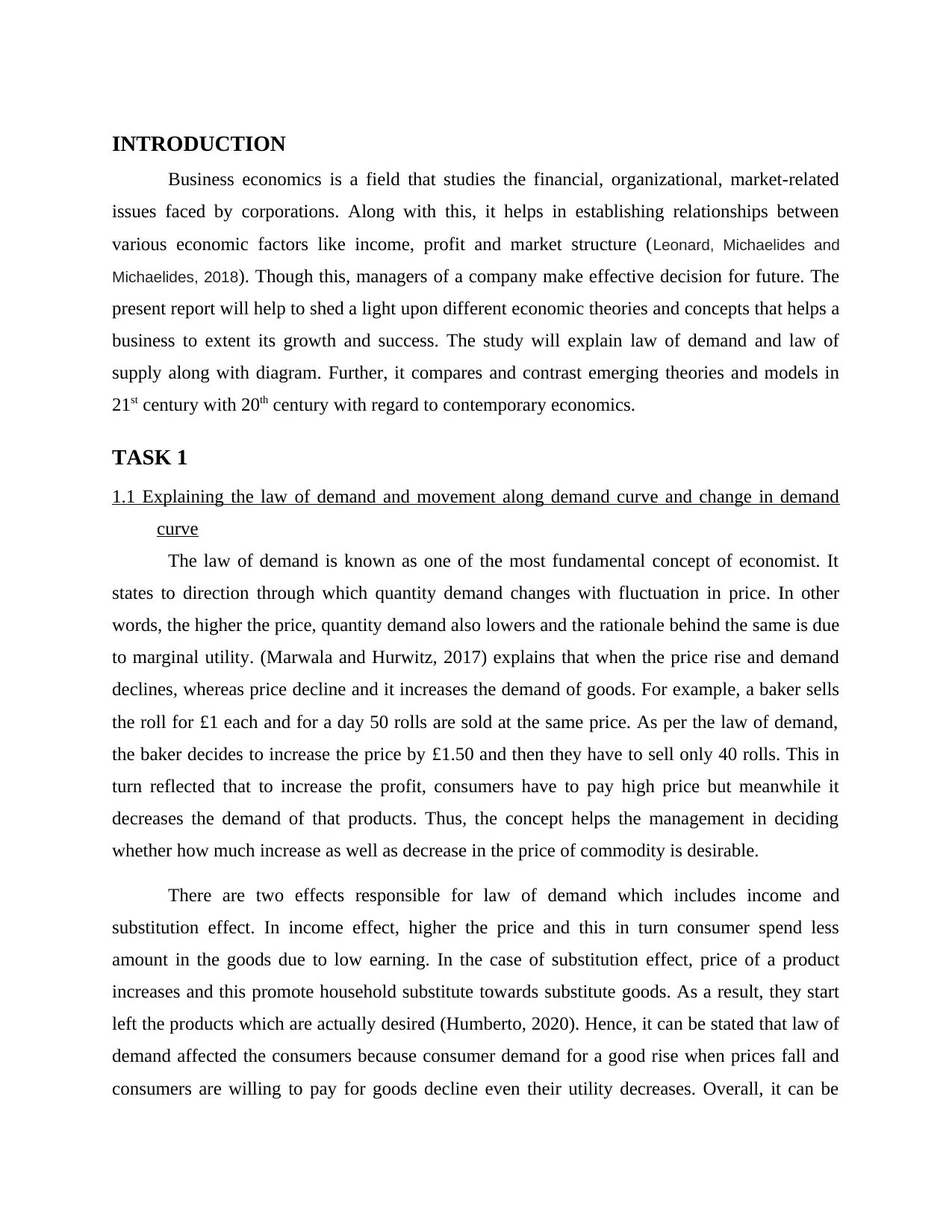
INTRODUCTION
Business economics is a field that studies the financial, organizational, market-related
issues faced by corporations. Along with this, it helps in establishing relationships between
various economic factors like income, profit and market structure (Leonard, Michaelides and
Michaelides, 2018). Though this, managers of a company make effective decision for future. The
present report will help to shed a light upon different economic theories and concepts that helps a
business to extent its growth and success. The study will explain law of demand and law of
supply along with diagram. Further, it compares and contrast emerging theories and models in
21st century with 20th century with regard to contemporary economics.
TASK 1
1.1 Explaining the law of demand and movement along demand curve and change in demand
curve
The law of demand is known as one of the most fundamental concept of economist. It
states to direction through which quantity demand changes with fluctuation in price. In other
words, the higher the price, quantity demand also lowers and the rationale behind the same is due
to marginal utility. (Marwala and Hurwitz, 2017) explains that when the price rise and demand
declines, whereas price decline and it increases the demand of goods. For example, a baker sells
the roll for £1 each and for a day 50 rolls are sold at the same price. As per the law of demand,
the baker decides to increase the price by £1.50 and then they have to sell only 40 rolls. This in
turn reflected that to increase the profit, consumers have to pay high price but meanwhile it
decreases the demand of that products. Thus, the concept helps the management in deciding
whether how much increase as well as decrease in the price of commodity is desirable.
There are two effects responsible for law of demand which includes income and
substitution effect. In income effect, higher the price and this in turn consumer spend less
amount in the goods due to low earning. In the case of substitution effect, price of a product
increases and this promote household substitute towards substitute goods. As a result, they start
left the products which are actually desired (Humberto, 2020). Hence, it can be stated that law of
demand affected the consumers because consumer demand for a good rise when prices fall and
consumers are willing to pay for goods decline even their utility decreases. Overall, it can be
Business economics is a field that studies the financial, organizational, market-related
issues faced by corporations. Along with this, it helps in establishing relationships between
various economic factors like income, profit and market structure (Leonard, Michaelides and
Michaelides, 2018). Though this, managers of a company make effective decision for future. The
present report will help to shed a light upon different economic theories and concepts that helps a
business to extent its growth and success. The study will explain law of demand and law of
supply along with diagram. Further, it compares and contrast emerging theories and models in
21st century with 20th century with regard to contemporary economics.
TASK 1
1.1 Explaining the law of demand and movement along demand curve and change in demand
curve
The law of demand is known as one of the most fundamental concept of economist. It
states to direction through which quantity demand changes with fluctuation in price. In other
words, the higher the price, quantity demand also lowers and the rationale behind the same is due
to marginal utility. (Marwala and Hurwitz, 2017) explains that when the price rise and demand
declines, whereas price decline and it increases the demand of goods. For example, a baker sells
the roll for £1 each and for a day 50 rolls are sold at the same price. As per the law of demand,
the baker decides to increase the price by £1.50 and then they have to sell only 40 rolls. This in
turn reflected that to increase the profit, consumers have to pay high price but meanwhile it
decreases the demand of that products. Thus, the concept helps the management in deciding
whether how much increase as well as decrease in the price of commodity is desirable.
There are two effects responsible for law of demand which includes income and
substitution effect. In income effect, higher the price and this in turn consumer spend less
amount in the goods due to low earning. In the case of substitution effect, price of a product
increases and this promote household substitute towards substitute goods. As a result, they start
left the products which are actually desired (Humberto, 2020). Hence, it can be stated that law of
demand affected the consumers because consumer demand for a good rise when prices fall and
consumers are willing to pay for goods decline even their utility decreases. Overall, it can be
⊘ This is a preview!⊘
Do you want full access?
Subscribe today to unlock all pages.

Trusted by 1+ million students worldwide
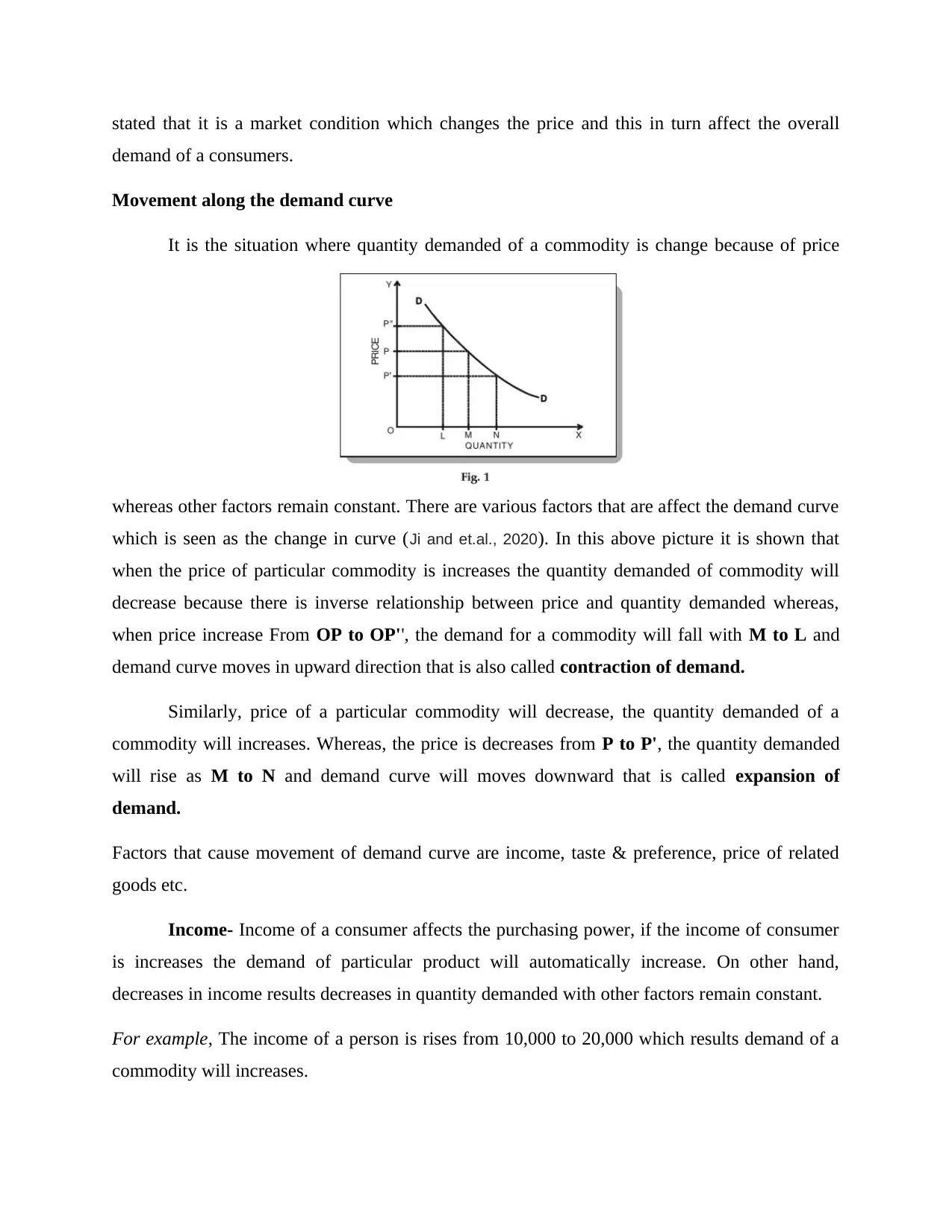
stated that it is a market condition which changes the price and this in turn affect the overall
demand of a consumers.
Movement along the demand curve
It is the situation where quantity demanded of a commodity is change because of price
whereas other factors remain constant. There are various factors that are affect the demand curve
which is seen as the change in curve (Ji and et.al., 2020). In this above picture it is shown that
when the price of particular commodity is increases the quantity demanded of commodity will
decrease because there is inverse relationship between price and quantity demanded whereas,
when price increase From OP to OP'', the demand for a commodity will fall with M to L and
demand curve moves in upward direction that is also called contraction of demand.
Similarly, price of a particular commodity will decrease, the quantity demanded of a
commodity will increases. Whereas, the price is decreases from P to P', the quantity demanded
will rise as M to N and demand curve will moves downward that is called expansion of
demand.
Factors that cause movement of demand curve are income, taste & preference, price of related
goods etc.
Income- Income of a consumer affects the purchasing power, if the income of consumer
is increases the demand of particular product will automatically increase. On other hand,
decreases in income results decreases in quantity demanded with other factors remain constant.
For example, The income of a person is rises from 10,000 to 20,000 which results demand of a
commodity will increases.
demand of a consumers.
Movement along the demand curve
It is the situation where quantity demanded of a commodity is change because of price
whereas other factors remain constant. There are various factors that are affect the demand curve
which is seen as the change in curve (Ji and et.al., 2020). In this above picture it is shown that
when the price of particular commodity is increases the quantity demanded of commodity will
decrease because there is inverse relationship between price and quantity demanded whereas,
when price increase From OP to OP'', the demand for a commodity will fall with M to L and
demand curve moves in upward direction that is also called contraction of demand.
Similarly, price of a particular commodity will decrease, the quantity demanded of a
commodity will increases. Whereas, the price is decreases from P to P', the quantity demanded
will rise as M to N and demand curve will moves downward that is called expansion of
demand.
Factors that cause movement of demand curve are income, taste & preference, price of related
goods etc.
Income- Income of a consumer affects the purchasing power, if the income of consumer
is increases the demand of particular product will automatically increase. On other hand,
decreases in income results decreases in quantity demanded with other factors remain constant.
For example, The income of a person is rises from 10,000 to 20,000 which results demand of a
commodity will increases.
Paraphrase This Document
Need a fresh take? Get an instant paraphrase of this document with our AI Paraphraser
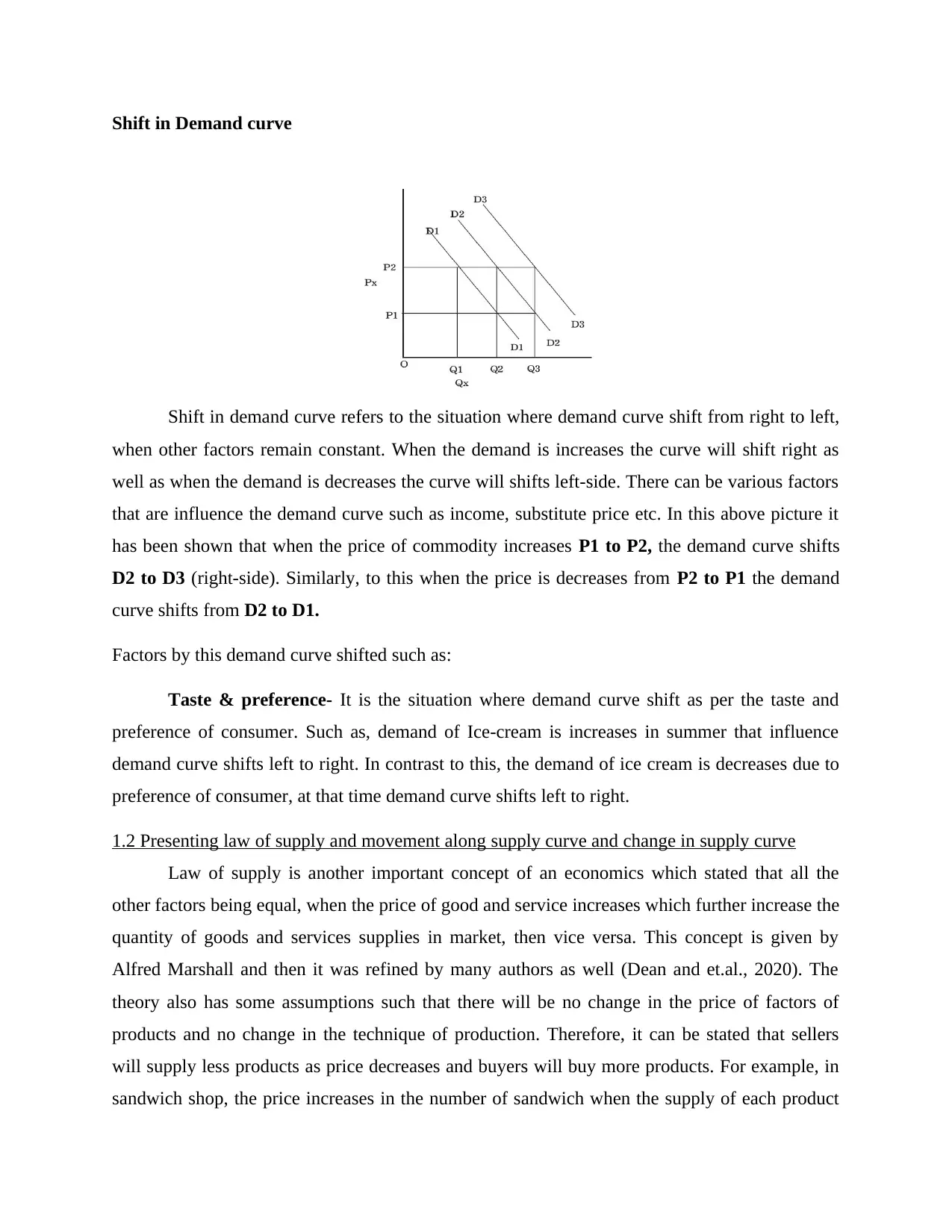
Shift in Demand curve
Shift in demand curve refers to the situation where demand curve shift from right to left,
when other factors remain constant. When the demand is increases the curve will shift right as
well as when the demand is decreases the curve will shifts left-side. There can be various factors
that are influence the demand curve such as income, substitute price etc. In this above picture it
has been shown that when the price of commodity increases P1 to P2, the demand curve shifts
D2 to D3 (right-side). Similarly, to this when the price is decreases from P2 to P1 the demand
curve shifts from D2 to D1.
Factors by this demand curve shifted such as:
Taste & preference- It is the situation where demand curve shift as per the taste and
preference of consumer. Such as, demand of Ice-cream is increases in summer that influence
demand curve shifts left to right. In contrast to this, the demand of ice cream is decreases due to
preference of consumer, at that time demand curve shifts left to right.
1.2 Presenting law of supply and movement along supply curve and change in supply curve
Law of supply is another important concept of an economics which stated that all the
other factors being equal, when the price of good and service increases which further increase the
quantity of goods and services supplies in market, then vice versa. This concept is given by
Alfred Marshall and then it was refined by many authors as well (Dean and et.al., 2020). The
theory also has some assumptions such that there will be no change in the price of factors of
products and no change in the technique of production. Therefore, it can be stated that sellers
will supply less products as price decreases and buyers will buy more products. For example, in
sandwich shop, the price increases in the number of sandwich when the supply of each product
Shift in demand curve refers to the situation where demand curve shift from right to left,
when other factors remain constant. When the demand is increases the curve will shift right as
well as when the demand is decreases the curve will shifts left-side. There can be various factors
that are influence the demand curve such as income, substitute price etc. In this above picture it
has been shown that when the price of commodity increases P1 to P2, the demand curve shifts
D2 to D3 (right-side). Similarly, to this when the price is decreases from P2 to P1 the demand
curve shifts from D2 to D1.
Factors by this demand curve shifted such as:
Taste & preference- It is the situation where demand curve shift as per the taste and
preference of consumer. Such as, demand of Ice-cream is increases in summer that influence
demand curve shifts left to right. In contrast to this, the demand of ice cream is decreases due to
preference of consumer, at that time demand curve shifts left to right.
1.2 Presenting law of supply and movement along supply curve and change in supply curve
Law of supply is another important concept of an economics which stated that all the
other factors being equal, when the price of good and service increases which further increase the
quantity of goods and services supplies in market, then vice versa. This concept is given by
Alfred Marshall and then it was refined by many authors as well (Dean and et.al., 2020). The
theory also has some assumptions such that there will be no change in the price of factors of
products and no change in the technique of production. Therefore, it can be stated that sellers
will supply less products as price decreases and buyers will buy more products. For example, in
sandwich shop, the price increases in the number of sandwich when the supply of each product
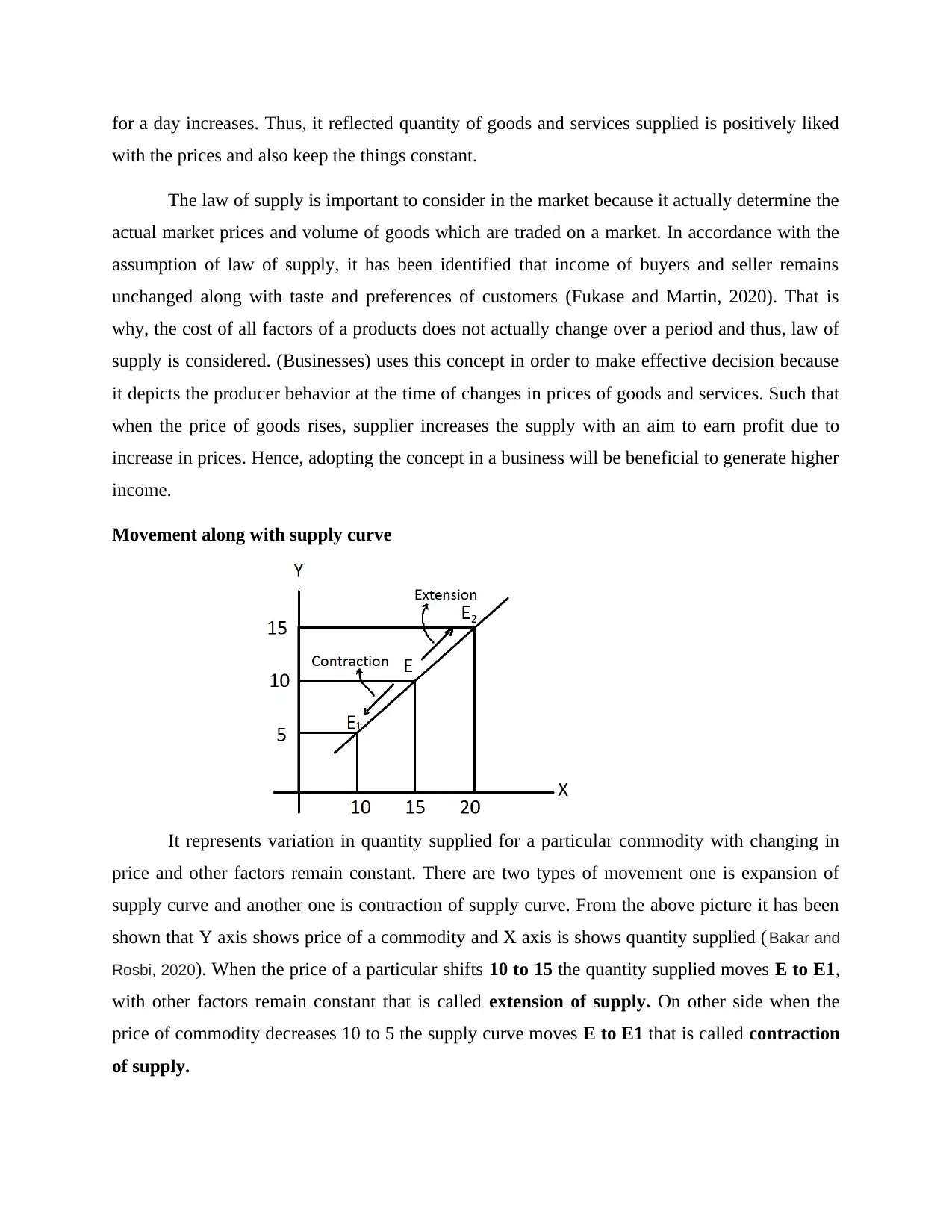
for a day increases. Thus, it reflected quantity of goods and services supplied is positively liked
with the prices and also keep the things constant.
The law of supply is important to consider in the market because it actually determine the
actual market prices and volume of goods which are traded on a market. In accordance with the
assumption of law of supply, it has been identified that income of buyers and seller remains
unchanged along with taste and preferences of customers (Fukase and Martin, 2020). That is
why, the cost of all factors of a products does not actually change over a period and thus, law of
supply is considered. (Businesses) uses this concept in order to make effective decision because
it depicts the producer behavior at the time of changes in prices of goods and services. Such that
when the price of goods rises, supplier increases the supply with an aim to earn profit due to
increase in prices. Hence, adopting the concept in a business will be beneficial to generate higher
income.
Movement along with supply curve
It represents variation in quantity supplied for a particular commodity with changing in
price and other factors remain constant. There are two types of movement one is expansion of
supply curve and another one is contraction of supply curve. From the above picture it has been
shown that Y axis shows price of a commodity and X axis is shows quantity supplied (Bakar and
Rosbi, 2020). When the price of a particular shifts 10 to 15 the quantity supplied moves E to E1,
with other factors remain constant that is called extension of supply. On other side when the
price of commodity decreases 10 to 5 the supply curve moves E to E1 that is called contraction
of supply.
with the prices and also keep the things constant.
The law of supply is important to consider in the market because it actually determine the
actual market prices and volume of goods which are traded on a market. In accordance with the
assumption of law of supply, it has been identified that income of buyers and seller remains
unchanged along with taste and preferences of customers (Fukase and Martin, 2020). That is
why, the cost of all factors of a products does not actually change over a period and thus, law of
supply is considered. (Businesses) uses this concept in order to make effective decision because
it depicts the producer behavior at the time of changes in prices of goods and services. Such that
when the price of goods rises, supplier increases the supply with an aim to earn profit due to
increase in prices. Hence, adopting the concept in a business will be beneficial to generate higher
income.
Movement along with supply curve
It represents variation in quantity supplied for a particular commodity with changing in
price and other factors remain constant. There are two types of movement one is expansion of
supply curve and another one is contraction of supply curve. From the above picture it has been
shown that Y axis shows price of a commodity and X axis is shows quantity supplied (Bakar and
Rosbi, 2020). When the price of a particular shifts 10 to 15 the quantity supplied moves E to E1,
with other factors remain constant that is called extension of supply. On other side when the
price of commodity decreases 10 to 5 the supply curve moves E to E1 that is called contraction
of supply.
⊘ This is a preview!⊘
Do you want full access?
Subscribe today to unlock all pages.

Trusted by 1+ million students worldwide
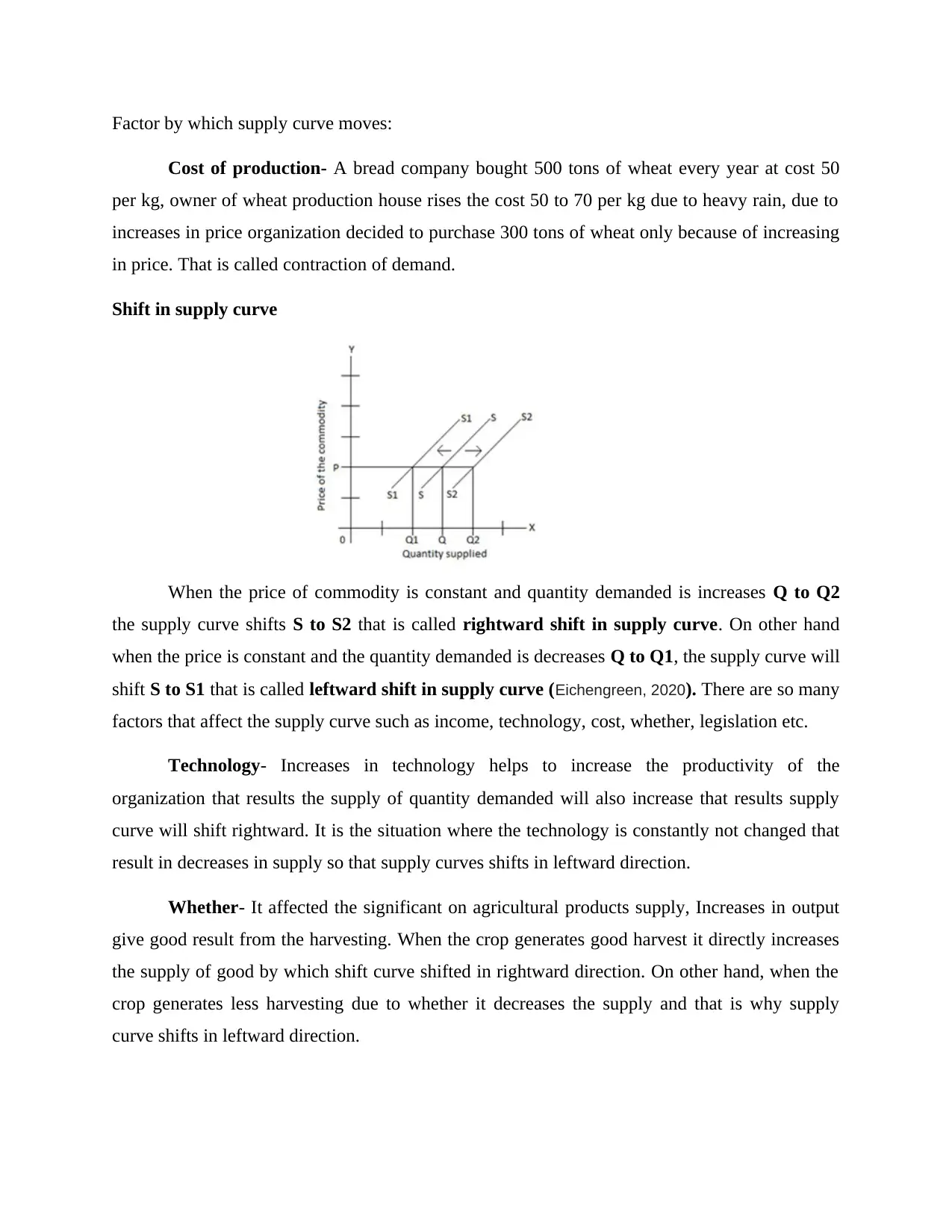
Factor by which supply curve moves:
Cost of production- A bread company bought 500 tons of wheat every year at cost 50
per kg, owner of wheat production house rises the cost 50 to 70 per kg due to heavy rain, due to
increases in price organization decided to purchase 300 tons of wheat only because of increasing
in price. That is called contraction of demand.
Shift in supply curve
When the price of commodity is constant and quantity demanded is increases Q to Q2
the supply curve shifts S to S2 that is called rightward shift in supply curve. On other hand
when the price is constant and the quantity demanded is decreases Q to Q1, the supply curve will
shift S to S1 that is called leftward shift in supply curve (Eichengreen, 2020). There are so many
factors that affect the supply curve such as income, technology, cost, whether, legislation etc.
Technology- Increases in technology helps to increase the productivity of the
organization that results the supply of quantity demanded will also increase that results supply
curve will shift rightward. It is the situation where the technology is constantly not changed that
result in decreases in supply so that supply curves shifts in leftward direction.
Whether- It affected the significant on agricultural products supply, Increases in output
give good result from the harvesting. When the crop generates good harvest it directly increases
the supply of good by which shift curve shifted in rightward direction. On other hand, when the
crop generates less harvesting due to whether it decreases the supply and that is why supply
curve shifts in leftward direction.
Cost of production- A bread company bought 500 tons of wheat every year at cost 50
per kg, owner of wheat production house rises the cost 50 to 70 per kg due to heavy rain, due to
increases in price organization decided to purchase 300 tons of wheat only because of increasing
in price. That is called contraction of demand.
Shift in supply curve
When the price of commodity is constant and quantity demanded is increases Q to Q2
the supply curve shifts S to S2 that is called rightward shift in supply curve. On other hand
when the price is constant and the quantity demanded is decreases Q to Q1, the supply curve will
shift S to S1 that is called leftward shift in supply curve (Eichengreen, 2020). There are so many
factors that affect the supply curve such as income, technology, cost, whether, legislation etc.
Technology- Increases in technology helps to increase the productivity of the
organization that results the supply of quantity demanded will also increase that results supply
curve will shift rightward. It is the situation where the technology is constantly not changed that
result in decreases in supply so that supply curves shifts in leftward direction.
Whether- It affected the significant on agricultural products supply, Increases in output
give good result from the harvesting. When the crop generates good harvest it directly increases
the supply of good by which shift curve shifted in rightward direction. On other hand, when the
crop generates less harvesting due to whether it decreases the supply and that is why supply
curve shifts in leftward direction.
Paraphrase This Document
Need a fresh take? Get an instant paraphrase of this document with our AI Paraphraser
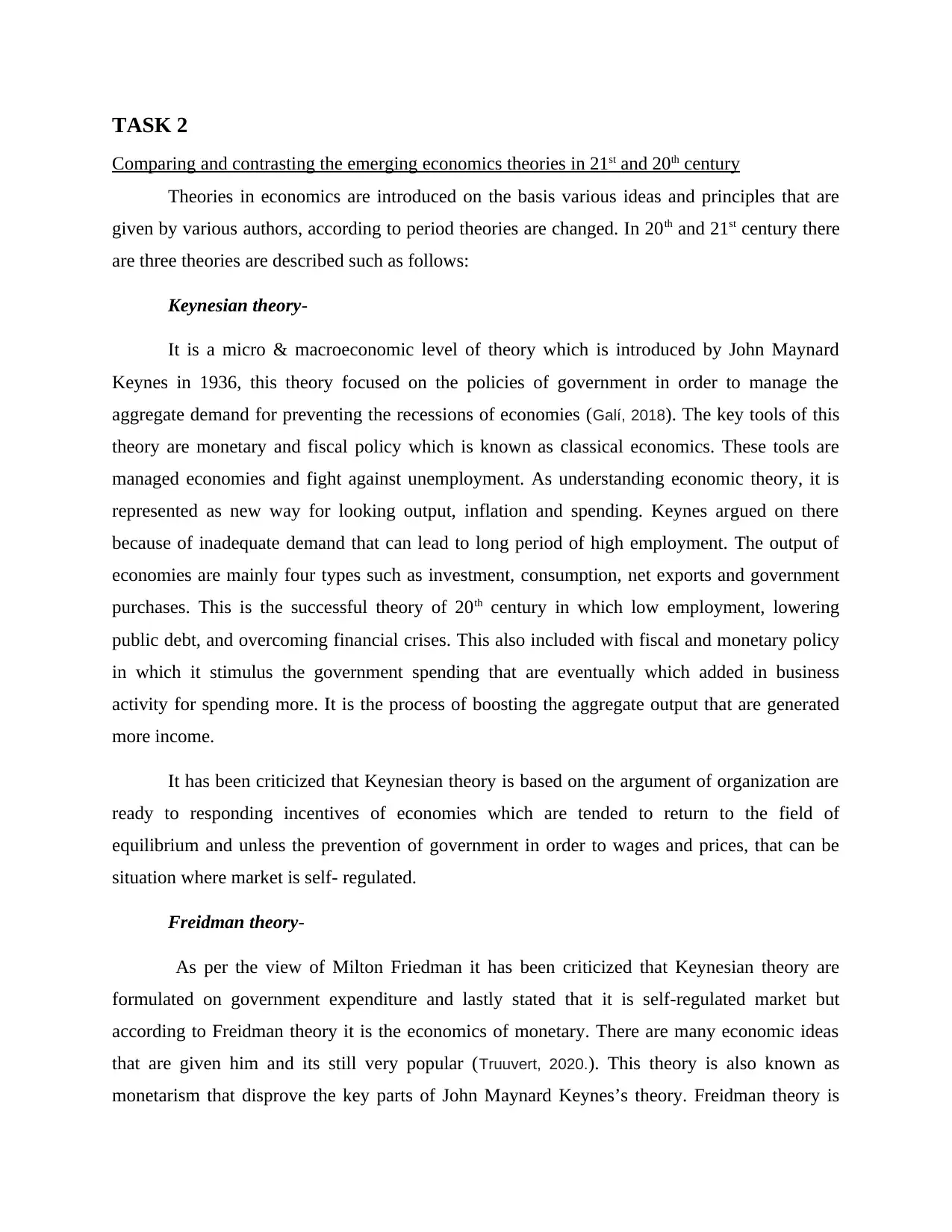
TASK 2
Comparing and contrasting the emerging economics theories in 21st and 20th century
Theories in economics are introduced on the basis various ideas and principles that are
given by various authors, according to period theories are changed. In 20th and 21st century there
are three theories are described such as follows:
Keynesian theory-
It is a micro & macroeconomic level of theory which is introduced by John Maynard
Keynes in 1936, this theory focused on the policies of government in order to manage the
aggregate demand for preventing the recessions of economies (Galí, 2018). The key tools of this
theory are monetary and fiscal policy which is known as classical economics. These tools are
managed economies and fight against unemployment. As understanding economic theory, it is
represented as new way for looking output, inflation and spending. Keynes argued on there
because of inadequate demand that can lead to long period of high employment. The output of
economies are mainly four types such as investment, consumption, net exports and government
purchases. This is the successful theory of 20th century in which low employment, lowering
public debt, and overcoming financial crises. This also included with fiscal and monetary policy
in which it stimulus the government spending that are eventually which added in business
activity for spending more. It is the process of boosting the aggregate output that are generated
more income.
It has been criticized that Keynesian theory is based on the argument of organization are
ready to responding incentives of economies which are tended to return to the field of
equilibrium and unless the prevention of government in order to wages and prices, that can be
situation where market is self- regulated.
Freidman theory-
As per the view of Milton Friedman it has been criticized that Keynesian theory are
formulated on government expenditure and lastly stated that it is self-regulated market but
according to Freidman theory it is the economics of monetary. There are many economic ideas
that are given him and its still very popular (Truuvert, 2020.). This theory is also known as
monetarism that disprove the key parts of John Maynard Keynes’s theory. Freidman theory is
Comparing and contrasting the emerging economics theories in 21st and 20th century
Theories in economics are introduced on the basis various ideas and principles that are
given by various authors, according to period theories are changed. In 20th and 21st century there
are three theories are described such as follows:
Keynesian theory-
It is a micro & macroeconomic level of theory which is introduced by John Maynard
Keynes in 1936, this theory focused on the policies of government in order to manage the
aggregate demand for preventing the recessions of economies (Galí, 2018). The key tools of this
theory are monetary and fiscal policy which is known as classical economics. These tools are
managed economies and fight against unemployment. As understanding economic theory, it is
represented as new way for looking output, inflation and spending. Keynes argued on there
because of inadequate demand that can lead to long period of high employment. The output of
economies are mainly four types such as investment, consumption, net exports and government
purchases. This is the successful theory of 20th century in which low employment, lowering
public debt, and overcoming financial crises. This also included with fiscal and monetary policy
in which it stimulus the government spending that are eventually which added in business
activity for spending more. It is the process of boosting the aggregate output that are generated
more income.
It has been criticized that Keynesian theory is based on the argument of organization are
ready to responding incentives of economies which are tended to return to the field of
equilibrium and unless the prevention of government in order to wages and prices, that can be
situation where market is self- regulated.
Freidman theory-
As per the view of Milton Friedman it has been criticized that Keynesian theory are
formulated on government expenditure and lastly stated that it is self-regulated market but
according to Freidman theory it is the economics of monetary. There are many economic ideas
that are given him and its still very popular (Truuvert, 2020.). This theory is also known as
monetarism that disprove the key parts of John Maynard Keynes’s theory. Freidman theory is
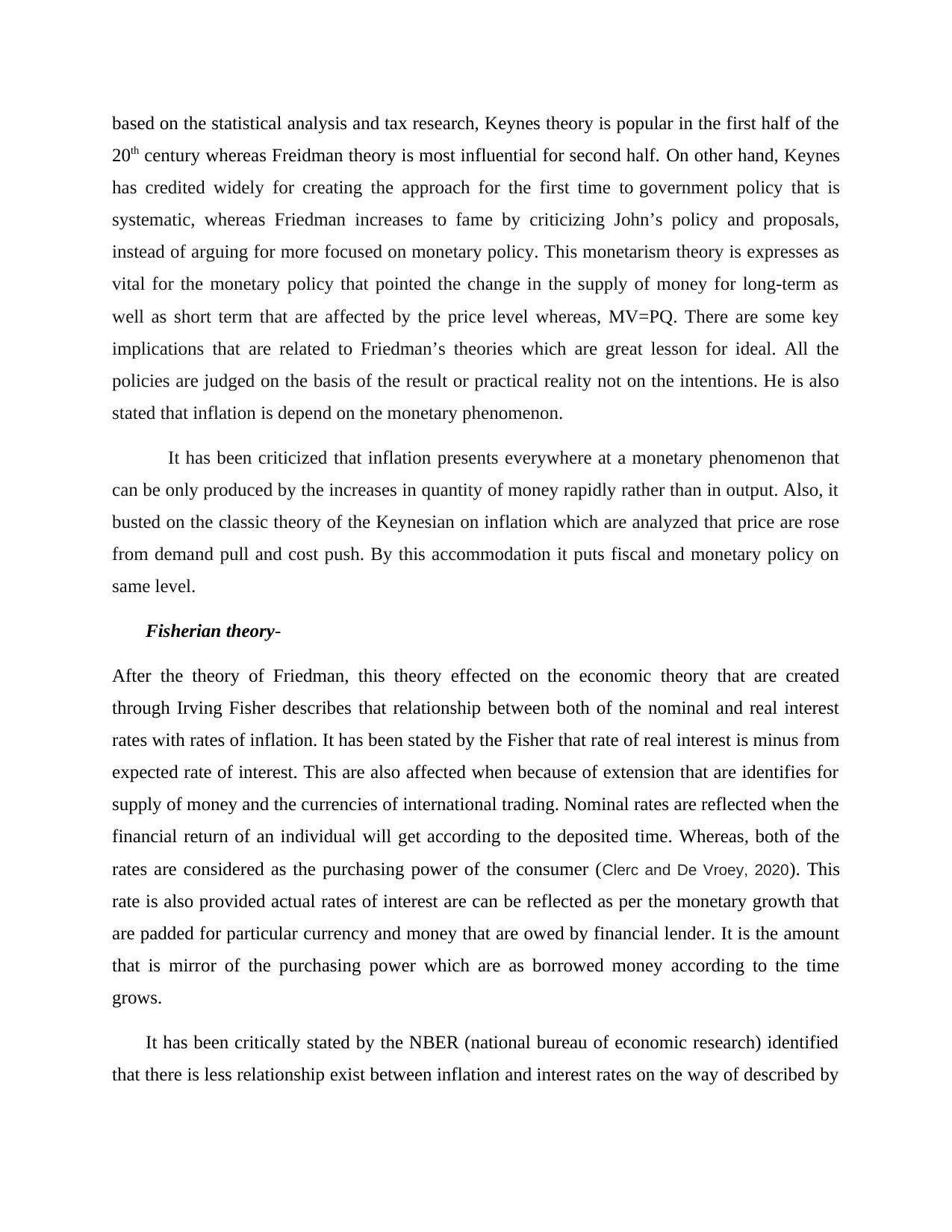
based on the statistical analysis and tax research, Keynes theory is popular in the first half of the
20th century whereas Freidman theory is most influential for second half. On other hand, Keynes
has credited widely for creating the approach for the first time to government policy that is
systematic, whereas Friedman increases to fame by criticizing John’s policy and proposals,
instead of arguing for more focused on monetary policy. This monetarism theory is expresses as
vital for the monetary policy that pointed the change in the supply of money for long-term as
well as short term that are affected by the price level whereas, MV=PQ. There are some key
implications that are related to Friedman’s theories which are great lesson for ideal. All the
policies are judged on the basis of the result or practical reality not on the intentions. He is also
stated that inflation is depend on the monetary phenomenon.
It has been criticized that inflation presents everywhere at a monetary phenomenon that
can be only produced by the increases in quantity of money rapidly rather than in output. Also, it
busted on the classic theory of the Keynesian on inflation which are analyzed that price are rose
from demand pull and cost push. By this accommodation it puts fiscal and monetary policy on
same level.
Fisherian theory-
After the theory of Friedman, this theory effected on the economic theory that are created
through Irving Fisher describes that relationship between both of the nominal and real interest
rates with rates of inflation. It has been stated by the Fisher that rate of real interest is minus from
expected rate of interest. This are also affected when because of extension that are identifies for
supply of money and the currencies of international trading. Nominal rates are reflected when the
financial return of an individual will get according to the deposited time. Whereas, both of the
rates are considered as the purchasing power of the consumer (Clerc and De Vroey, 2020). This
rate is also provided actual rates of interest are can be reflected as per the monetary growth that
are padded for particular currency and money that are owed by financial lender. It is the amount
that is mirror of the purchasing power which are as borrowed money according to the time
grows.
It has been critically stated by the NBER (national bureau of economic research) identified
that there is less relationship exist between inflation and interest rates on the way of described by
20th century whereas Freidman theory is most influential for second half. On other hand, Keynes
has credited widely for creating the approach for the first time to government policy that is
systematic, whereas Friedman increases to fame by criticizing John’s policy and proposals,
instead of arguing for more focused on monetary policy. This monetarism theory is expresses as
vital for the monetary policy that pointed the change in the supply of money for long-term as
well as short term that are affected by the price level whereas, MV=PQ. There are some key
implications that are related to Friedman’s theories which are great lesson for ideal. All the
policies are judged on the basis of the result or practical reality not on the intentions. He is also
stated that inflation is depend on the monetary phenomenon.
It has been criticized that inflation presents everywhere at a monetary phenomenon that
can be only produced by the increases in quantity of money rapidly rather than in output. Also, it
busted on the classic theory of the Keynesian on inflation which are analyzed that price are rose
from demand pull and cost push. By this accommodation it puts fiscal and monetary policy on
same level.
Fisherian theory-
After the theory of Friedman, this theory effected on the economic theory that are created
through Irving Fisher describes that relationship between both of the nominal and real interest
rates with rates of inflation. It has been stated by the Fisher that rate of real interest is minus from
expected rate of interest. This are also affected when because of extension that are identifies for
supply of money and the currencies of international trading. Nominal rates are reflected when the
financial return of an individual will get according to the deposited time. Whereas, both of the
rates are considered as the purchasing power of the consumer (Clerc and De Vroey, 2020). This
rate is also provided actual rates of interest are can be reflected as per the monetary growth that
are padded for particular currency and money that are owed by financial lender. It is the amount
that is mirror of the purchasing power which are as borrowed money according to the time
grows.
It has been critically stated by the NBER (national bureau of economic research) identified
that there is less relationship exist between inflation and interest rates on the way of described by
⊘ This is a preview!⊘
Do you want full access?
Subscribe today to unlock all pages.

Trusted by 1+ million students worldwide
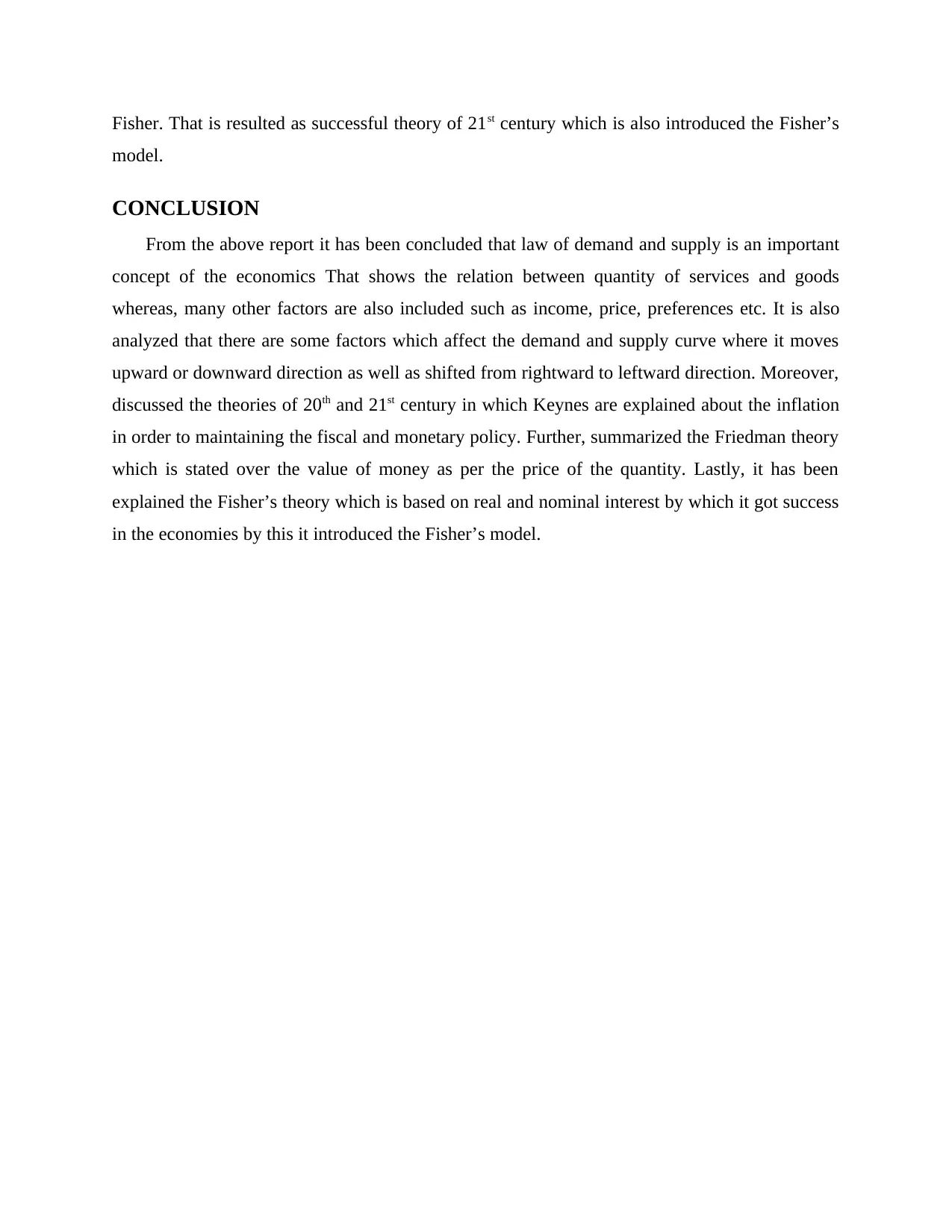
Fisher. That is resulted as successful theory of 21st century which is also introduced the Fisher’s
model.
CONCLUSION
From the above report it has been concluded that law of demand and supply is an important
concept of the economics That shows the relation between quantity of services and goods
whereas, many other factors are also included such as income, price, preferences etc. It is also
analyzed that there are some factors which affect the demand and supply curve where it moves
upward or downward direction as well as shifted from rightward to leftward direction. Moreover,
discussed the theories of 20th and 21st century in which Keynes are explained about the inflation
in order to maintaining the fiscal and monetary policy. Further, summarized the Friedman theory
which is stated over the value of money as per the price of the quantity. Lastly, it has been
explained the Fisher’s theory which is based on real and nominal interest by which it got success
in the economies by this it introduced the Fisher’s model.
model.
CONCLUSION
From the above report it has been concluded that law of demand and supply is an important
concept of the economics That shows the relation between quantity of services and goods
whereas, many other factors are also included such as income, price, preferences etc. It is also
analyzed that there are some factors which affect the demand and supply curve where it moves
upward or downward direction as well as shifted from rightward to leftward direction. Moreover,
discussed the theories of 20th and 21st century in which Keynes are explained about the inflation
in order to maintaining the fiscal and monetary policy. Further, summarized the Friedman theory
which is stated over the value of money as per the price of the quantity. Lastly, it has been
explained the Fisher’s theory which is based on real and nominal interest by which it got success
in the economies by this it introduced the Fisher’s model.
Paraphrase This Document
Need a fresh take? Get an instant paraphrase of this document with our AI Paraphraser
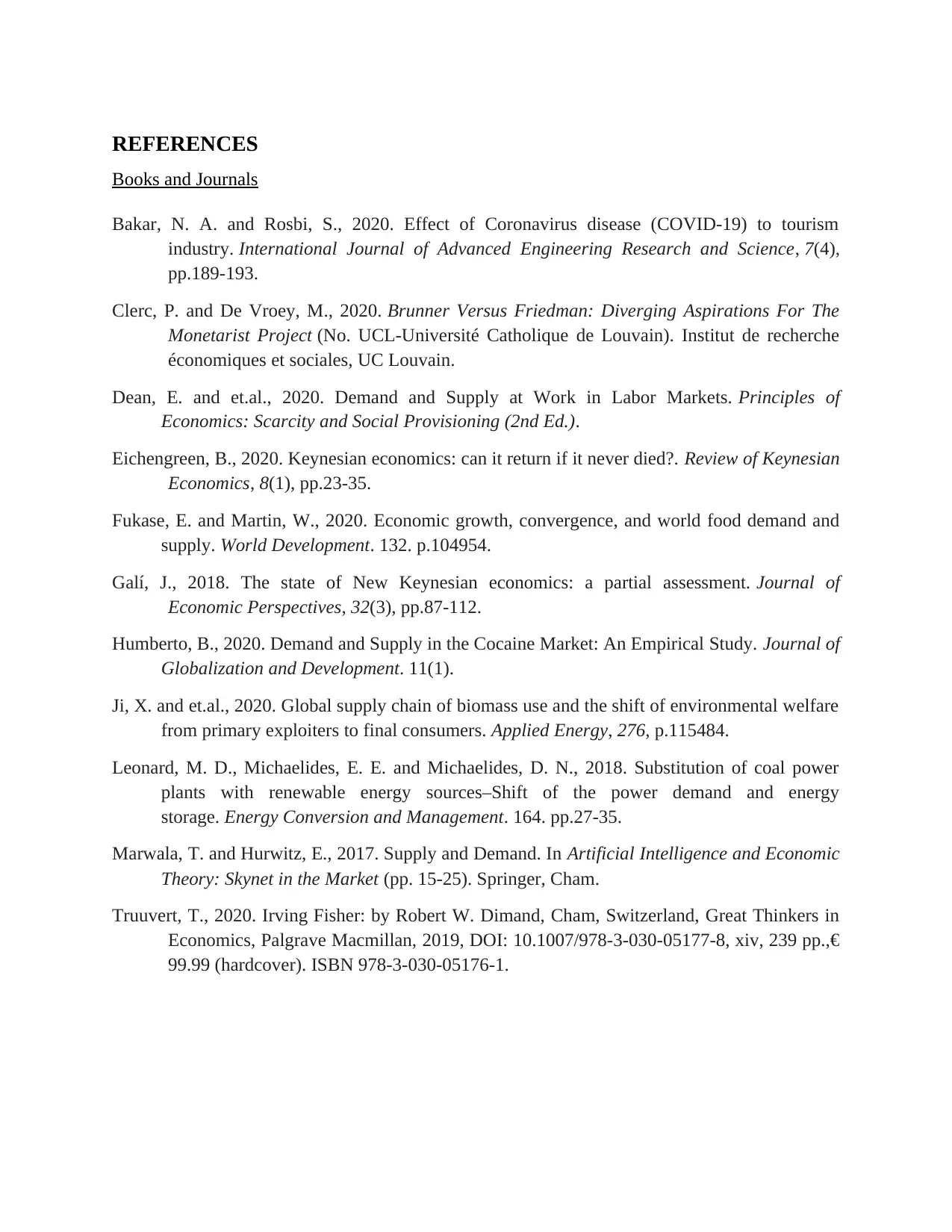
REFERENCES
Books and Journals
Bakar, N. A. and Rosbi, S., 2020. Effect of Coronavirus disease (COVID-19) to tourism
industry. International Journal of Advanced Engineering Research and Science, 7(4),
pp.189-193.
Clerc, P. and De Vroey, M., 2020. Brunner Versus Friedman: Diverging Aspirations For The
Monetarist Project (No. UCL-Université Catholique de Louvain). Institut de recherche
économiques et sociales, UC Louvain.
Dean, E. and et.al., 2020. Demand and Supply at Work in Labor Markets. Principles of
Economics: Scarcity and Social Provisioning (2nd Ed.).
Eichengreen, B., 2020. Keynesian economics: can it return if it never died?. Review of Keynesian
Economics, 8(1), pp.23-35.
Fukase, E. and Martin, W., 2020. Economic growth, convergence, and world food demand and
supply. World Development. 132. p.104954.
Galí, J., 2018. The state of New Keynesian economics: a partial assessment. Journal of
Economic Perspectives, 32(3), pp.87-112.
Humberto, B., 2020. Demand and Supply in the Cocaine Market: An Empirical Study. Journal of
Globalization and Development. 11(1).
Ji, X. and et.al., 2020. Global supply chain of biomass use and the shift of environmental welfare
from primary exploiters to final consumers. Applied Energy, 276, p.115484.
Leonard, M. D., Michaelides, E. E. and Michaelides, D. N., 2018. Substitution of coal power
plants with renewable energy sources–Shift of the power demand and energy
storage. Energy Conversion and Management. 164. pp.27-35.
Marwala, T. and Hurwitz, E., 2017. Supply and Demand. In Artificial Intelligence and Economic
Theory: Skynet in the Market (pp. 15-25). Springer, Cham.
Truuvert, T., 2020. Irving Fisher: by Robert W. Dimand, Cham, Switzerland, Great Thinkers in
Economics, Palgrave Macmillan, 2019, DOI: 10.1007/978-3-030-05177-8, xiv, 239 pp.,€
99.99 (hardcover). ISBN 978-3-030-05176-1.
Books and Journals
Bakar, N. A. and Rosbi, S., 2020. Effect of Coronavirus disease (COVID-19) to tourism
industry. International Journal of Advanced Engineering Research and Science, 7(4),
pp.189-193.
Clerc, P. and De Vroey, M., 2020. Brunner Versus Friedman: Diverging Aspirations For The
Monetarist Project (No. UCL-Université Catholique de Louvain). Institut de recherche
économiques et sociales, UC Louvain.
Dean, E. and et.al., 2020. Demand and Supply at Work in Labor Markets. Principles of
Economics: Scarcity and Social Provisioning (2nd Ed.).
Eichengreen, B., 2020. Keynesian economics: can it return if it never died?. Review of Keynesian
Economics, 8(1), pp.23-35.
Fukase, E. and Martin, W., 2020. Economic growth, convergence, and world food demand and
supply. World Development. 132. p.104954.
Galí, J., 2018. The state of New Keynesian economics: a partial assessment. Journal of
Economic Perspectives, 32(3), pp.87-112.
Humberto, B., 2020. Demand and Supply in the Cocaine Market: An Empirical Study. Journal of
Globalization and Development. 11(1).
Ji, X. and et.al., 2020. Global supply chain of biomass use and the shift of environmental welfare
from primary exploiters to final consumers. Applied Energy, 276, p.115484.
Leonard, M. D., Michaelides, E. E. and Michaelides, D. N., 2018. Substitution of coal power
plants with renewable energy sources–Shift of the power demand and energy
storage. Energy Conversion and Management. 164. pp.27-35.
Marwala, T. and Hurwitz, E., 2017. Supply and Demand. In Artificial Intelligence and Economic
Theory: Skynet in the Market (pp. 15-25). Springer, Cham.
Truuvert, T., 2020. Irving Fisher: by Robert W. Dimand, Cham, Switzerland, Great Thinkers in
Economics, Palgrave Macmillan, 2019, DOI: 10.1007/978-3-030-05177-8, xiv, 239 pp.,€
99.99 (hardcover). ISBN 978-3-030-05176-1.
1 out of 11
Related Documents
Your All-in-One AI-Powered Toolkit for Academic Success.
+13062052269
info@desklib.com
Available 24*7 on WhatsApp / Email
![[object Object]](/_next/static/media/star-bottom.7253800d.svg)
Unlock your academic potential
Copyright © 2020–2025 A2Z Services. All Rights Reserved. Developed and managed by ZUCOL.





